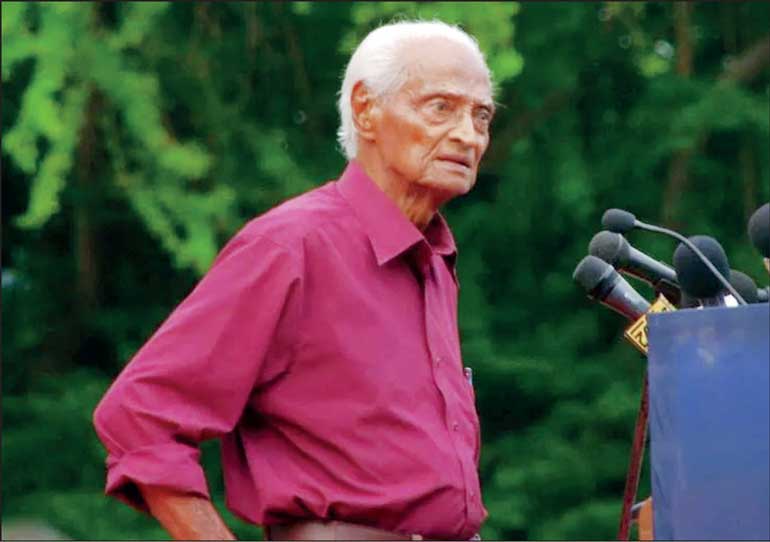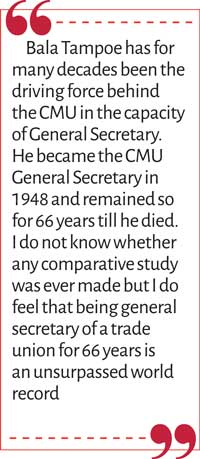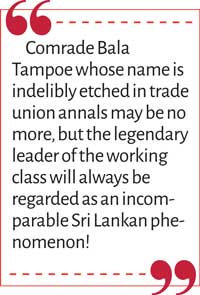Friday Dec 05, 2025
Friday Dec 05, 2025
Wednesday, 25 May 2022 00:30 - - {{hitsCtrl.values.hits}}

Bala Tampoe was a colourful personality of multiple dimensions
 The “Political Pulse” column focuses this week on a man who was perhaps the last of the great trade unionists. A legend in his lifetime who was at the helm of a vibrant trade union continuously for a period of 66 years – an unsurpassed record! I am of course referring to comrade Bala Tampoe who was the Ceylon Mercantile Union (CMU) General Secretary from 1948 to 2014. Though called the CMU still, the amended name of the union is now The Ceylon Mercantile, Industrial and General Workers Union. The trade union firebrand is no more with us having passed away in September 2014. Bala Tampoe’s birth centenary was on 23 May.
The “Political Pulse” column focuses this week on a man who was perhaps the last of the great trade unionists. A legend in his lifetime who was at the helm of a vibrant trade union continuously for a period of 66 years – an unsurpassed record! I am of course referring to comrade Bala Tampoe who was the Ceylon Mercantile Union (CMU) General Secretary from 1948 to 2014. Though called the CMU still, the amended name of the union is now The Ceylon Mercantile, Industrial and General Workers Union. The trade union firebrand is no more with us having passed away in September 2014. Bala Tampoe’s birth centenary was on 23 May.
Bala Tampoe was a colourful personality of multiple dimensions. Underground member of the Lanka Sama Samaaja Party (LSSP), during the Second World War days; Agricultural Dept. lecturer who lost his job due to involvement in a general strike; leader of the same trade union for more than six decades; fiery orator known for defiant speeches; witness of the Independence ceremony of Ceylon when the Union Jack was replaced; key organiser of the historic 1953 ‘Hartal’; one-time Central Committee and Politbureau member of the largest Trotskyite party recognised by the fourth international; architect of many strikes, including one which paralysed the Colombo harbour causing declaration of emergency; one of the trouble-making leftists earmarked for incarceration at the Naval armoury by the 1962 coup d’etat planners; pioneer of a collective agreement that proved to be a model for many such agreements; trade union leader who ushered in the payment of allowance scheme based on the rise in the cost of living index; man behind a series of strikes leading to progressive measures regarding termination of employment; co-leader of revolutionary breakaway group in LSSP that formed its own party; unsuccessful candidate in three parliamentary polls; lawyer who defended JVP comrades free-of-charge after the 1971 insurgency; dedicated trade unionist who drove to office and back for six days of work, even at the age of 92. These are, but a few facets of comrade Bala Tampoe.
Being General Secretary of the CMU for 66 years since 1948, has been a marvellous achievement. All the more so because of comrade Bala’s ethnicity in Sri Lanka’s deeply divided society. Philips Balendra Tampoe was of Jaffna Tamil origin. The membership of the CMU though multi-ethnic is predominantly Sinhala. This fact has been highlighted often by many observers of Sri Lanka’s political scene. It is however noteworthy that Bala had never ever projected himself as an Ethnic Tamil or engaged in communal politics.
Bala was born in Negombo on 23 May 1922. Both his parents were of Jaffna Tamil stock. His father, Francis Tampoe-Philips was an excise officer under British rule who served in various parts of what was then known as the Madras Presidency in India. Bala’s mother Beatrice Thangamma Saverimuttu, though hailing from Jaffna, was born in Kurunegala. Her father was Mudaliyar A.G. Saverimuttu who had been the Chief Post Master at the General Post Office in Colombo for many years. The rank of Mudaliyar had been conferred on him by the British rulers in recognition of his distinguished service to the crown.
Francis Tampoe-Philips was an excise officer under British rule who served in various parts of what was then known as the Madras Presidency in India. Bala’s mother Beatrice Thangamma Saverimuttu, though hailing from Jaffna, was born in Kurunegala. Her father was Mudaliyar A.G. Saverimuttu who had been the Chief Post Master at the General Post Office in Colombo for many years. The rank of Mudaliyar had been conferred on him by the British rulers in recognition of his distinguished service to the crown.
Trotskyite Bala was born and baptised as a Christian. His given name then was Balendra Tampoe-Philips. Due to compelling circumstances during school days, his mother registered his name as Philips Balendra Tampoe when admitting him to Royal College in 1934. Ten years later, after graduating Bala was appointed as a lecturer in Botany and Horticulture at the Peradeniya School of Agriculture in February 1944. It was then that he legally changed his name to Philips Balendra Tampoe and placed advertisements to that effect in newspapers. He became known thereafter in a general sense as Bala (derived from Balendra) Tampoe or PB Tampoe.
Foray into electoral politics
Though an active trade unionist, Bala Tampoe did dabble in electoral politics for some years. However his foray into Parliamentary politics did not meet with much success. Bala Tampoe first contested Parliamentary elections in 1960. He was fielded by the Lanka Sama Samaja Party (LSSP) under the key symbol in the multi-member constituency of Colombo Central returning three MP’s. March 1960 polls were held at a time when the LSSP was expected to romp home as winners with Dr. N.M. Perera becoming Prime Minister. Bala was expected to come first in Colombo Central. Yet, it was Dr. M.C.M. Kaleel and Ranasinghe Premadasa of the UNP, along with the Communist party’s Pieter Keuneman who won. Bala Tampoe came fourth out of 15 candidates polling 22,228 votes.
In the July 1960 elections, the number of candidates had dwindled to six. For some reason, the expectation again was that Bala Tampoe would be elected as first MP. But again that was not to be. Sir. Razeek Fareed from the SLFP came first with Pieter Keuneman and Dr. Kaleel coming second and third respectively. Bala Tampoe came fifth, behind Ranasinghe Premadasa. His vote tally had shrunk to 16,406.
The LSSP underwent a crisis in 1964 when the party leadership opted to form a coalition govt. with the SLFP, led by Prime Minister Sirimavo Bandaranaike. 14 members of the then LSSP Central Committee dissented. These included Bulathsinhala MP Edmund Samarakkody, Moratuwa MP Meryl Fernando, Theoretician V. Karalasingham and Bala Tampoe. The dissident group formed the LSSP-R or LSSP-Revolutionary party minus the Karlo group of Karalasingham that rejoined the parent body. The mainstream LSSP was expelled from the fourth international and the LSSP-R was recognised in its place as the Ceylon section of the fourth international.
The LSSP-R contested the 1965 parliamentary elections but did not fare well. Bala Tampoe contested in Colombo Central again but this time under the lamp and not key symbol. He came fifth out of ten candidates polling only 4,559 votes.
The LSSP-R experienced further fragmentation when Edmund Samarakkody left the LSSP-R after engaging in a vitriolic campaign against Bala Tampoe. The Edmund faction formed the Revolutionary Samasamajist Party. Later on it became the Revolutionary Workers party.
The LSSP-R continued to be under the sway of Bala Tampoe. The CMU was its mainstay. The LSSP-R did not contest the 1970 General elections and accused the LSSP and Communist party of “misleading the masses”. The party too was renamed as the Revolutionary Marxist Party (RMP) and continued to be recognised as the Ceylon/Sri Lanka affiliate of the United Secretariat of the fourth international for several years.
In 1977, Bala Tampoe reversed the earlier position of not contesting parliamentary polls and fielded a few candidates at the July hustings. Bala Tampoe himself did not contest. The CMU and RMP together put forward four candidates on a “revolutionary socialist platform” calling for “the overthrow of capitalist rule and the establishment of a Workers’ and Peasants’ Government by the masses”.
Upali Cooray and T.N. Perera contested on behalf of the RMP in Dehiwela and Kesbewa, while Vernon Wijesinghe and H.A. Seneviratne were put forward by the CMU in Colombo North and Kelaniya. All four fought the election campaign under the bell symbol. The results were a disaster. The four candidates got 402, 298, 193 and 162 in Dehiwela, Kesbewa, Colombo North and Kelaniya respectively.
The failure of the Parliamentary path, and the personal electoral defeats of Bala Tampoe in 1960 and 1965 were blessings in disguise for trade unionism in general and the CMU in particular.
CMU General Secretary for 66 years
Though called the CMU still, the amended name of the union is now The Ceylon Mercantile, Industrial and General Workers Union. Bala Tampoe has for many decades been the driving force behind the CMU in the capacity of General Secretary. He became the CMU General Secretary in 1948 and remained so for 66 years till he died. I do not know whether any comparative study was ever made but I do feel that being general secretary of a trade union for 66 years is an unsurpassed world record.
The CMU at its hey-day had 37,500 members. It was powerful and influential. Bala Tampoe in the sixties of the last century, organised a series of more than 70 strikes across the country protesting the way employers could summarily dismiss workers. This led to the then Prime Minister Dudley Senanayake meeting with him to discuss ways and means of addressing the issue. Bala Tampoe proposed that the State should step in and examine grounds for removal. Tampoe submitted a legal draft which laid the foundation for the Termination of Employment Act that was enacted in 1971.
The veteran trade unionist was married twice and had two children. His first wife was Nancy Kotalawela from Passara. She was a Montessori teacher. They married on 28 October 1950. The son Dhiresh was born on 1 December 1951; and daughter Shyama on 6 January 1956. They separated in 1957, and were divorced in April 1966. Nancy migrated to the United States in September 1967, with the two children.
Bala Tampoe’s second wife was May Wickramasuriya who was an institution by herself. They were married on 22 September 1966. May worked at the CMU for decades and was well-known in trade union and Trotskyite circles. She had joined the CMU in 1951 and remained an efficient colleague and loyal companion to Bala Tampoe.
She became assistant secretary of the CMU in 1956. May was paralysed after suffering a stroke in November 1995. She died a few years later on 15 December 1998. CMU contemporaries speak highly of the fond affection with which Bala cared for her. Bala describes her as his “companion and comrade”. There is a conference room named after May at the CMU office.
 Fascinated me since childhood
Fascinated me since childhood
Bala Tampoe has been one of those formidable figures who have fascinated me since childhood. I first heard of Bala Tampoe as a six-year-old boy in 1960. There were two parliamentary elections that year in March and July.
We were then living in Hulftsdorp which came under the Colombo Central electorate. PB Tampoe or Bala Tampoe contested Colombo Central in both elections as a Lanka Sama Samaaja Party (LSSP) candidate under the key symbol. It was during the election campaign that I first heard of Bala Tampoe whose name was in wide circulation in the Colombo Central constituency.
My father would take me along for meetings conducted by the LSSP. He had been an ardent supporter of the LSSP from his schooldays. Since Bala Tampoe was the Colombo Central candidate I saw much of him at election meetings. There were posters and leaflets all over the area. Bala Tampoe with his fire and brimstone speeches made an indelible impression on me even though I could not comprehend all that he was saying then.
The larger than life image of Bala Tampoe instilled in me since childhood kept growing as I too grew up. Many relatives and friends in the private sector were CMU members and the stories they told about Tampoe enhanced his image further in my eyes.
The Janatha Vimukthi Peramuna (JVP) led insurgency of 1971 captured the imagination of youths in the seventies. Bala Tampoe aided by a team of dedicated lawyers appeared for many of the accused at the Criminal Justice Commission. He had taken his oaths as an advocate in 1954. Even as I lapped up newspaper reports of the proceedings eagerly, my esteem for Bala Tampoe increased.
Interacting with Bala personally
I began interacting with Bala personally when I entered journalism through the Tamil daily “Virakesari” in 1977. This inter-action continued even after I moved into English journalism via “The Island”. When I first joined the newspaper in November 1981 I used to cover the Trade Union and Customs as my regular beat. My first lead story at “The Island” had some points made by Bala Tampoe and former CWC General Secretary M.S. Sellasamy through interviews.
However I was soon put on the Tamil political round at “The Island”. With the ethnic crisis escalating the “Tamil round” assumed crucial importance. I found myself writing many news stories and articles and even a weekly column pertaining to the ethnic problem. The trade union beat was taken off. My interaction with Bala Tampoe gradually ceased. In 1988 I left the shores of Sri Lanka.
The year 2013 was a blessed year for me as I got the opportunity of returning to Sri Lanka after 25 years. After travelling about and visiting relatives and close friends I began meeting “other” people during the latter stages of my stay in Sri Lanka. One such person was Bala Tampoe.
I went to the CMU headquarters in Kollupitiya one morning after a friend had secured an appointment to meet Bala Tampoe. The CMU office that buzzed vibrantly with activity at one time seemed relatively quiet now.
When I walked into the hall and saw Bala from afar, the nonagenarian seemed to look the same despite the withering gaze of age. When I got closer I could see the toll of nine decades. Yet he was quite sprightly in his walk and had a firm handshake as usual. The physical movements were somewhat slower but unimpaired. His hair remained still with a silvery grey hue.
Doughty fighter for workers’ rights
When I sat down to converse I discovered that the fire in the doughty fighter for workers’ rights was still ablaze. He was in full command of his faculties. His mind was razor sharp as usual. The flow of ideas and words gushed forth as in the past. The familiar gritting of teeth frequently occurred. The fiery glint in his eyes was very visible at close quarters. His memory was fantastic.
It was while conversing with Bala that I realised what a treasure trove of information the trade union veteran was. From D.S. Senanayake to Chandrika Kumaratunga he had seen many rulers “come and go” but Bala Tampoe like Tennyson’s brook had kept going “on forever”.
Until his demise Bala Tampoe lived alone in Ratmalana. The CMU office is in Kollupitiya. Each day he drove from home to work and work to home. Bala had a vintage Volkswagon which he drove for decades. He worked six days a week and at times seven, depending upon necessity. His workday was around 7 to 8 hours daily.
I asked Bala Tampoe in 2013 as to how he managed to lead such a busy, strenuous life at his age. What was the secret of his long life, good health, and youthful energy? He replied pensively: “I think there are genetic as well as other reasons for my having lived thus far, with the capacity to drive to work and back between my house in Ratmalana and the CMU headquarters in Colpetty, five to six days a week, for a full day’s work. One is that I cannot let go of the needs of the Union and its members. Another is that I have been fairly frugal in my diet, and have never been given to excesses in anything but my activities on behalf of others. I also can’t yet bring myself to think of myself as old, as I remain young at heart and in mind.”
A nonagenarian’s daily routine
I also asked Bala once to tell me his daily routine. He responded in writing as follows: “I usually wake to the sounds of early birds chirping outside my bedroom window, between 5:15 and 6 a.m. I then make myself a cup of tea, and sit down at my laptop, to check my email and respond thereto straightaway sometimes, or just browse a bit on the internet, before I prepare my breakfast.”
“It normally consists of cereals, mixed in a little milk with curd, a spoonful of kitul honey and a sliced kolikuttu plantain. I am giving you those details because people sometimes ask me about my daily diet, when questioning me about “my secret”, as you’ve done.”
“I normally leave for the CMU headquarters by 8.30 a.m., driving my old Volkswagen which I have had re-conditioned recently. The Union spends for its maintenance and costs of petrol for my daily travelling to and from the headquarters. I preferred that to the Union’s purchasing a new car for me, as its General Council had wished. One of my reasons for that preference was that I am too advanced in years to need a car for much longer than I’ve driven the one I have!”
“My working day now normally ends by 5 p.m. but continues till 8.00 or even 9.00 p.m. on Wednesdays, when the Executive Committee or the Working Committee meet alternately, from week to week. It takes me about an hour to drive home to Ratmalana.”
“I have a short nap in the afternoons at the headquarters but have found it desirable as age creeps upon me, to have a longer nap when I get home, before warming my dinner (prepared for me at the headquarters) on a microwave oven.”
“After dinner, I stretch my legs a bit, walking around the house for about fifteen minutes, before normally settling down to watch a DVD film till 11 p.m. or later, depending on how absorbing it is and how tired I may be at end of the day – and so it ends!
Incomparable Sri Lankan phenomenon!
The end came finally! Philips Balendra Tampoe known to all as Bala Tampoe passed way on 1 September 2014. Comrade Bala Tampoe whose name is indelibly etched in trade union annals may be no more, but the legendary leader of the working class will always be regarded as an incomparable Sri Lankan phenomenon!
(This is a modified version of two earlier articles.)
(The writer can be reached at [email protected].)